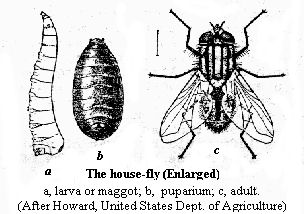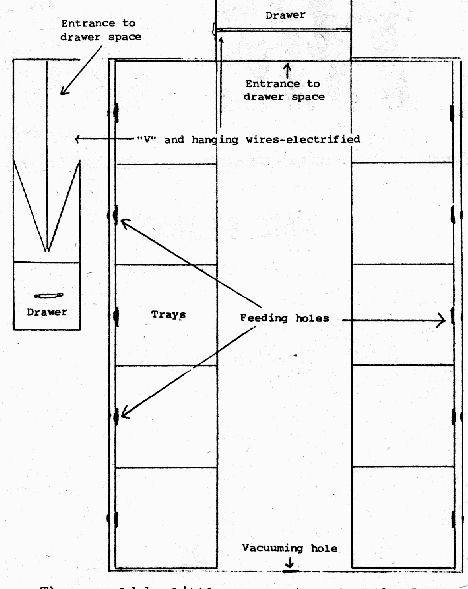| Welcome
To Our "Survival Foods & Their Preparation" Section |
THE FANTASTIC FLY!
by Kurt Saxon
From THE SURVIVOR; Volume Six: Issue 12
You've probably never given it a thought but the common house-fly is a potential asset to anyone with chickens to feed. The following ideas will enable you to cut your feed bills to zero and even give you feed to sell. (See also THE SURVIVOR Vol. 1, pages 12, 39 and 110).
The common house-fly and the larger blue and green thoraxes flies are wildly prolific. Estimates have been made that if one pair of flies should be allowed to breed with no deaths, in one year they would weigh as much as the Earth itself.

Consider, one fly weighs about a grain with 1500 grains to the ounce. A female will lay about 120 eggs. I don't know the ratio of females to males but let's say half, or 60 females. The cycle from egg to egg-laying female is 10 days to two weeks.
Say you captured a male and female hung together in the act of mating. Put them in a cloth covered box with a moist slice of baloney and keep it in a warm place. In a few hours the female will lay her 120 eggs. Soon thereafter the eggs will hatch into maggots. After eating the constantly moistened baloney for a few days the maggots will pupate and soon again, adult flies will emerge from the pupa cases and commence to mate and eat, eat and mate, and just lay oodles more eggs. (No need to capture a pair of flies in the act of mating. Just get three or four flies and one or more of them will certainly be females)
If you should expand your operation, in four weeks you would have 3600 females. Two more weeks and you would have 216,000. Another two weeks, 12,960,000. We're just counting probable females, remember? In 12 weeks, or three months, would you believe 47,256,000,000?!
That approximates 31,504,000 ounces, or 1,969,000 pounds, or 984 tons! You would run out of baloney in no time. But going back to Survival City and the animal and human waste, there would be no running out.
We have already slated the waste from the chickens, rabbits and other livestock for earth- worms. But the human waste would be for flies.
Most state laws say that human waste is always waste and cannot be used for growing food directly. This is wise as cities and towns put so many chemicals down their sewers that any end product would be carcinogeous. But in Survival City, nothing but human waste would be put in the sewer system.
Even so, esthetics dictate against using it to directly fertilize plants. The Chinese have used "night soil" directly on plants for thousands of years. Some fields have up to six feet of topsoil. All night soil is avidly collected. Rurals even put up attractive outhouses along roads to entice passersby. So intent are the Chinese on utilizing night soil that a constipated Chinese is flogged and given high colonies.
The human waste for fly food would first go through a grinder similar to that described for all Survival City's plant and animal waste. This is because maggots can't eat what they can't get into their little mouths. After grinding the waste would go into a special digester which would generate methane, used as fuel. The methane process would generate enough heat to kill all bacteria and further break down the waste.
What would be left would be a vat of slurry covered by about two thirds of its volume of mineral-rich water. The water would be siphoned off into algae troughs and the slurry would be fed to the flies.
A fly-feeding unit I've designed would provide 120 one square yard by four inches deep plastic trays. As shown, they would be on racks, preferably of sheet-metal and would be 12 high with four inches of space between.
The fly room would be 15 by 10 feet and would hold 10 racks. It would be fully enclosed by window screen to keep the flies inside. In the bottom part of each tray would be a hole with a patch of rubber with a slit in it through which a nozzle would be inserted. The same kind of slit rubber patch would be over holes in the screen adjacent to each tray.
As the maggots ate themselves to pupahood they would rise to the top to pupate. It wouldn't do to put the new slurry on top of the pupas, thus killing them, so the slurry would have to well up from beneath. Two inches from the bottom of each tray would be fixed one square yard of rigid plastic with holes spaced every square inch.
Thus, as the slurry was consumed and the level went down, the slurry tube would be inserted through both rubber patches into the bottom half of the tray. Starting at the far end of the tray, the tube would be worked from side to side and withdrawn as the slurry welled up through the holes and caused the top level of slurry to rise, refilling the tray.
At one end of the screened-in fly room would be a screened section two feet wide by four feet long, at the bottom of which would be a drawer covering that area. Hanging from its center would be s system of electrified wires too close together for a fly to get through.
Flies touching the wires would be electrocuted and would drop through the slit of the electrified screens making a "V" just above the drawer. There would be a three eighths of an inch slit at the bottom of the "V" so the chances of a live fly getting into the drawer would be small.

There would be little reason to enter the fly room. At the end opposite the drawer would be another slit rubber patch for inserting a ten foot long tube to vacuum out any flies dying naturally.
If the unit were properly maintained, the drawer should be filled with dead flies several times a day.
Getting back to the algae, I've reprinted the findings of Robert Lawlor in his excellent article first printed the Dec. 1974 issue of ALTERNATE SOURCES OF ENERGY. I don't understand his thinking as he added urea and even carbon dioxide to his tanks, plus aeration. In summer, most ponds and ditches are covered by an inches thick layer of algae. It grows quite well naturally, taking its carbon dioxide from the water plus utilizing what minerals are in the water. If a portion of the algae were harvested each day and minerals were added, the crop would be much larger than it is naturally.
The mineral-rich soup siphoned off the slurry would supply all the minerals the algae needed to divide twice each day.
I suggest three foot wide, 20 feet long, one foot deep wooden, plastic-lined troughs filled with the water. The light from the sun or fluorescent lights, plus a possible heat source under the plastic should supply all the algae wanted.
The harvested algae could be mixed with the dead flies, dried and pelletized or broken up. As chicken feed it would supply all the protiens, vitamins and minerals required, even by chicks.
Although flies are known to be carriers of germs, this is only because wild flies seek decaying matter for food and for egg laying. These domesticated flies, feeding and laying their eggs on the nearly sterile slurry would be as germ-free as one could reasonably want.
My system is for producing in bulk to feed commercial flocks or to sell. But it could be scaled down to fit the needs of the individual.
Nor would one be confined to human waste. Any manure, chicken, rabbit, pig, cow, horse, etc. would do. For a clean product, however, it is urged that the manure first be subjected to the methane extraction process. This would not only provide free gas for the house but would produce a finer, cleaner slurry for the flies.
ENCYCLOPEDIA BRITANICA 1892
THE HOUSE-FLYThe minute dull chalky white eggs (usually about 120 in number), elongate oval and cylindrical in shape, are laid by the parent fly in crevices of fresh manure in or about stables,—heat, and especially moisture, being required for their development. The larval are hatched in twenty-four hours, and pass through three stages, averaging from five to seven days in all; in the second of its stages, the larva has been observed to increase by one-third of its length in twenty-four hours. They resemble those of the well-known meat fly, Ca.lliphora vomitoria, but are smaller, longer, more slender, transparent, smooth, and shining, and regularly conical. The prop-leg at the apex is also much smaller, and cannot be seen from above when the larva is in motion. They cat the decaying parts of the manure, leaving the bits of hay and straw. The puparium, or pupa- case, is a quarter of an inch long, cylindrical, and dark brown, closely resembling that of Stomoxys calcitrons, from which it chiefly differs in the larger and squarer anal spiracles and the smoother apex. The enclosed pupa is of the usual type of the cyclorhaphous Diptera, and is readily distinguishable from that of Siomoxys by its broad spatulate labium and curved maxillary palpi; it rests in the case with the hard framework of the jaws of the old larva skin next tho ventral side; and when the fly pushes its way out, after remaining from five to seven days as a pupa, the upper end of the case splits off just behind the suture between the thorax and abdomen. The term "pupa" is here used in a general sense, since intermediate stages of development (variously called "pseudo-nymph" or "semi-pupa") in that condition occur in the Muscidoe, as in Hymenoptcra, Colcopicra, &c.
On leaving the pupa-case, the fly runs about with its wings soft, small, and baggy, pressed to the side of the body, much as in the pupa. It is pale, with the colours not set, and the membranous portion of its forehead constantly distends with air as the fly moves, being connected with the trachere. From Mr Lowne's observations on the anatomy of the blow-fly, this organ is evidently employed for pushing away the end of inc puparum when the pupa slips out of its case.
The whole period of evolution being thus from ten to fourteen days only, and the number of eggs laid by each female fly so numerous, it will be readily seen tliat any slight personal inconveunience to man, as produced by the habits of the perfect insect, are much more than compensated for by the unceasing labours of its larvae as scavengers; the benefit being the more direct as the work is invariably done close to human habitations. The workings of the law of nature, by which an excess of increase in any one species is checked, are conspicuously shown in the case of this insect. Not only do the ordiuary parasites of its own class (some Hymenopterous, and in one recorded instance Coleopterous) attack it in its earlier stages, but certain common birds arc particularly addicted to it in the perfect stalte (in which also a Chelifer, a minute European representative of the scorpions, has also been found parasitically attached to it). The vegetable world also supplies some lethal agents in tlie shape of fungi (notably Empusa, muscoe), individuals destroyed by which are constantly to be, seen in autumn unable to move, and distended or ruptured by the expansion of the internal growth, the white spores of which are finally to bo observed scattered round their victim.
Trivial as the house-fly may appear even to entomologists, it is to be noted that recent obsurvations by the German biologist Wcissman on its development have resulted in his discovery of its possessing "imaginal discs" in the early larval state—a structure deemed of sufficient value to suggest a new division of the whole Insecta into "Discota" and " Adiscota."
